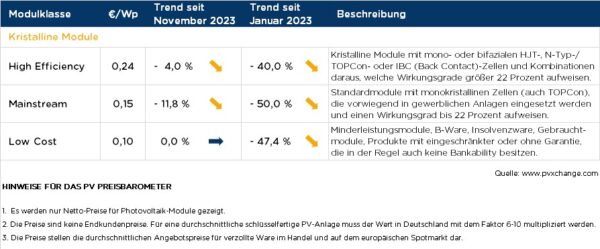Opinion
Rebuilding a complete value chain for fairly traded solar modules in Europe is a tempting prospect. Numerous local jobs could be created and Europeans may become independent of imports from regions of the world whose values they do not understand. Unfortunately, it will probably remain an unfulfillable dream for the foreseeable future, a wish on Santa’s list that unfortunately went unheeded again this year.
Module prices are too low and show no signs of increasing significantly in the foreseeable future. New goods from the ‘mainstream’ and ‘high efficiency’ sectors have become cheaper again, even if the trend can be seen to be weakening, at least for high-efficiency modules. Delivery and production volumes have apparently been significantly reduced to avoid a further increase in inventories in Europe. For a few products, demand is already exceeding supply, and deliveries are being postponed until next year. However, the situation is different for PERC mainstream modules. Many retailers and manufacturers still have horrendous inventories that need to be reduced. For this purpose, new low-price offers are placed on the market almost every day.
For this reason, one can currently only come to the conclusion that investments in new European production facilities, wherever they should be set up, are not worthwhile in the foreseeable future. In order to be even remotely competitive in terms of price, European products would have to be subsidized for years. Because new production cannot be set up and scaled as quickly as the race against the omnipresent Asian competition would require. The gap with China is already too great and is increasing every day. The concept of economies of scale no longer works here – other ideas are needed.
The costs for such an undertaking would be immense anyway – with an uncertain outcome. If we fail, our situation will be even more disastrous than before the race between unequal opponents began. I therefore advocate a more creative and intelligent approach. Special applications, products adapted to the rules and needs of the construction industry, and multifunctional systems must be developed and brought to market readiness.
The large manufacturers who focus on efficiency and cost savings find this difficult due to the often complex and regionally different requirements. However, there are already numerous such think tanks, these small and flexible manufacturers of special solutions on the continent. Why not take the small but fine manufacturers out of their niche and support and build them up with the already tight budget until they become a truly competitive industry – for intelligently adapted photovoltaic products outside the mainstream?
Overview of the price points differentiated by technology in December 2023 including the changes compared to the previous month (as of Dec. 13, 2023):
Author: Martin Schachinger
About the author: Martin Schachinger studied electrical engineering and has been active in the field of photovoltaics and renewable energy for almost 30 years. In 2004, he set up a business, founding the pvXchange.com online trading platform. The company stocks standard components for new installations and solar modules and inverters that are no longer being produced.
This article was originally published in pv magazine and is republished with permission.
Disclaimer: The articles and videos expressed in this publication are those of the authors. They do not purport to reflect the opinions or views of Green Building Africa, our staff or our advertisers. The designations employed in this publication and the presentation of material therein do not imply the expression of any opinion whatsoever on the part Green Building Africa concerning the legal status of any country, area or territory or of its authorities.
















